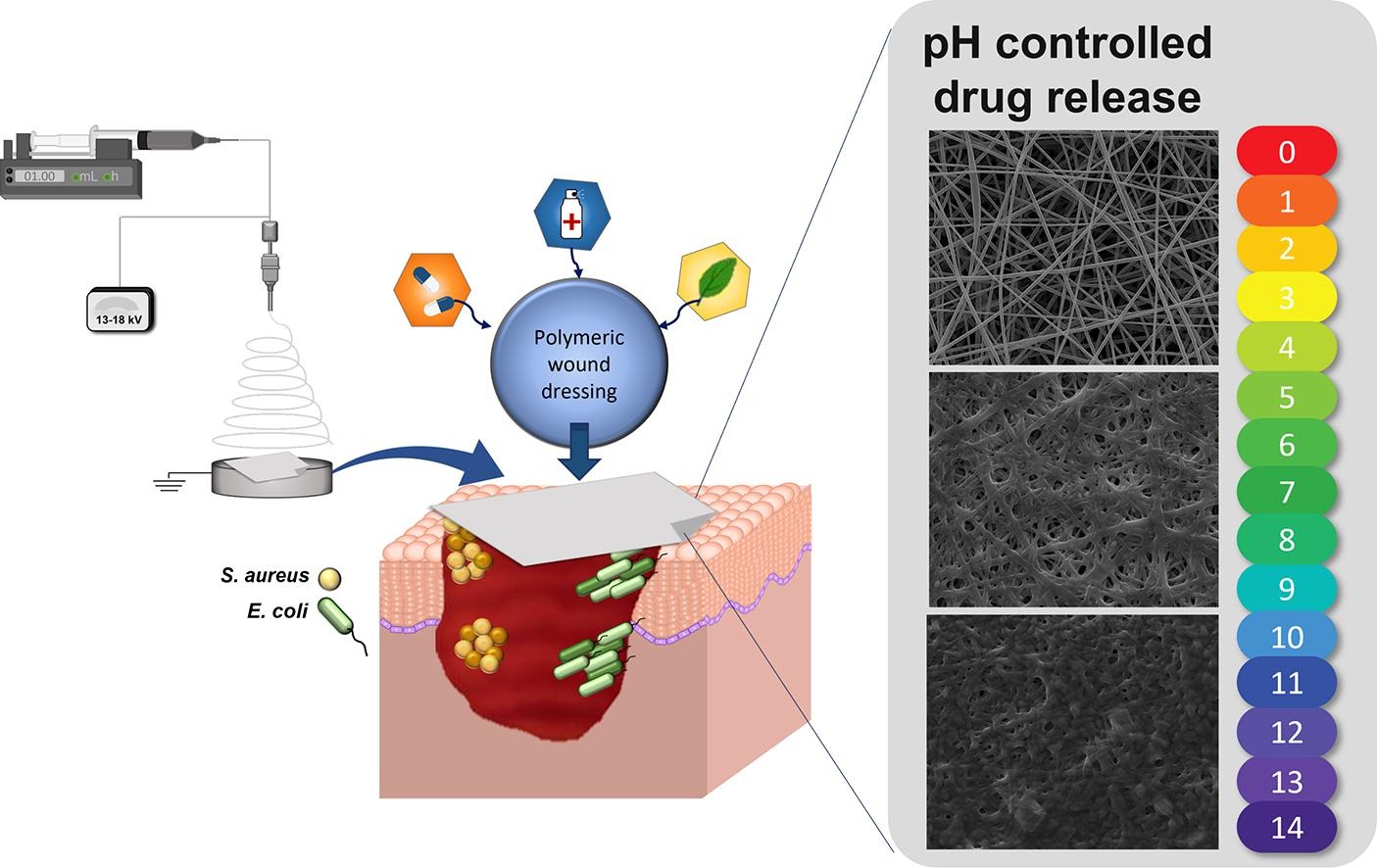Pharmacokinetic control on the release of antimicrobial drugs from pH-responsive electrospun wound dressings

The acidic pH of healthy skin changes during wound healing due to the exposure of the inner dermal and subcutaneous tissue and due to the potential colonization of pathogenic bacteria. In chronic non-healing wounds, the pH values vary in a wide pH range but the appearance of an alkaline shift is common. After a wound is incurred, neutral pH in the wound bed is characteristic of the activation of the cascade of regenerative and remodeling processes. In order to adjust drug release to the specific pH of the wound, herein, drug-loaded wound dressings having pH-responsiveness containing antiseptics and antibiotics and exerting different release kinetics in order to have a perfect match between the drug release kinetics, and the pH conditions of each wound type, were developed.
Highlights
• Drug loaded antibacterial pH-responsive polymeric electrospun wound dressings.
• Thymol, chlorohexidine and rifampicin loaded in Eudragit®-based fibers.
• Efficient antimicrobial action against gram positive and gram negative bacteria.
• Advanced drug eluting wound dressings having pH responsiveness.
We have fabricated drug-loaded electrospun nanofibers loaded with the antiseptic chlorhexidine, with the broad-spectrum antibiotic rifampicin, and with the antimicrobial of natural origin thymol, using the pH-dependent methacrylic acid copolymer Eudragit® L100-55, which dissolves at pH > 5.5; those drugs were loaded within Eudragit® S100, which dissolves at pH > 7 and, finally, within the methacrylic ester copolymer Eudragit® RS100 which is pH independent and slowly erodes and releases its contained cargo. The antibacterial action of those advanced wound dressings has been evaluated against methicillin-sensitive S. aureus Newman strain expressing the coral green fluorescent protein (cGFP), as a model of a Gram-positive bacteria, and against E. coli S17 strain as a model of a Gram-negative bacteria. It was demonstrated that those combinational products integrate in one device the required characteristics for a wound dressing with the therapeutic action of a contained active principle and can be selected depending on the wound acidic or alkaline status for its appropriated management.
Download the full article as PDF here Pharmacokinetic control on the release of antimicrobial drugs from pH-responsive electrospun wound dressings
Materials
Eudragit® L100-55 (L100-55), Eudragit® S100 (S100) and Eudragit® RS100 (RS100) were generously donated by Evonik Industries AG (Essen, Germany). Chloroform (CHCl3,anhydrous, ≥99%), N,N-Dimethylformamide (DMF, >99%), dimethyl sulfoxide (DMSO, >99%), Tween® 80, phosphate-buffered saline (PBS), tris(hydroxymethyl)aminomethane (Tris), rifampicin (RIF, ≥97%), chlorhexidine (CHXD, ≥99.5%) and thymol (THY, >98.5%) were purchased from Sigma-Aldrich (Darmstadt, Germany). Ethanol absolute (EtOH) was purchased from Panreac AppliChem (Barcelona, Spain). All reagents were used as received without any further purification. Tryptone soy broth (TSB) and tryptone soy agar (TSA) were purchased from Laboratorios Conda-Pronadisa SA (Madrid, Spain). GFP-expressing antibiotic-sensitive Staphylococcus aureus was kindly donated by Dr. Cristina Prat, Institut d’Investigació en Ciencies de la Salut Germans Trias i Pujol (IGTP, Spain) and Escherichia Coli S17 was kindly donated by Dr. Jose A. Ainsa, University of Zaragoza (Zaragoza, Spain). High-glucose Dulbecco’s modified Eagle’s medium (DMEM; DMEM w/stable glutamine) and antibiotic − antimycotic (60 μg/mL penicillin, 100 μg/mL streptomycin, and 0.25 μg/mL amphotericin B) were supplied by Biowest (Nuaille, France). The medium was supplemented with 10% (v/v) fetal bovine serum (FBS) from Gibco (Thermo Fisher Scientific, Waltham, Massachusetts, USA). The Blue® cell viability assay, used to evaluate potential cytotoxicity, was purchased from Abnova (Abnova GmbH, Taipei, Taiwan).
Laura Miranda-Calderon, Cristina Yus, Guillermo Landa, Gracia Mendoza, Manuel Arruebo, Silvia Irusta,
Pharmacokinetic control on the release of antimicrobial drugs from pH-responsive electrospun wound dressings,
International Journal of Pharmaceutics, Volume 624, 2022, 122003, ISSN 0378-5173,
https://doi.org/10.1016/j.ijpharm.2022.122003.

